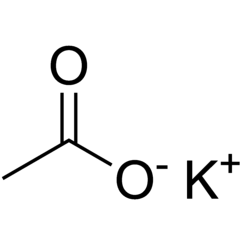You have no items in your shopping cart
Potassium acetate
Potassium acetate (CH3COOK) is the potassium salt of acetic acid.
Applications
Deicing
Potassium acetate can be used as a deicer to remove ice and prevent its formation. It is a substitute for chloride salts such as calcium chloride or magnesium chloride in deicing applications. It offers the advantage of being less aggressive on soils and much less corrosive, and for this reason, is preferred for airport runways. It is, however, more expensive.
Fire extinguishing
Potassium acetate is the extinguishing agent used in Class K fire extinguishers because of its ability to cool and form a crust over burning oils.
Food additive
Potassium acetate is used as a food additive as a preservative and acidity regulator. In the European Union, it is labeled by the E number E261; it is also approved for usage in the USA and Australia and New Zealand. Potassium hydrogen diacetate (CAS #4251-29-0 ) with formula KH(OOCCH3)2 is a related food additive with the same E number as potassium acetate.
Medicine and biochemistry
In medicine, potassium acetate is used as part of replacement protocols in the treatment of diabetic ketoacidosis because of its ability to break down into bicarbonate and help neutralize the acidotic state.
In molecular biology, potassium acetate is used to precipitate dodecyl sulfate (DS) and DS-bound proteins, allowing the removal of proteins from DNA. It is also used as a salt for the ethanol precipitation of DNA.
Potassium acetate is used in mixtures applied for tissue preservation, fixation, and mummification. Most museums today use the formaldehyde-based method recommended by Kaiserling in 1897 which contains potassium acetate. For example, Lenin's mummy was soaked in a bath containing potassium acetate.
Use in executions
Potassium acetate was incorrectly used in place of potassium chloride when putting a prisoner to death in Oklahoma in January 2015. In August 2017, the U.S. state of Florida executed Mark James Asay using a combination of etomidate, rocuronium bromide, and potassium acetate.


